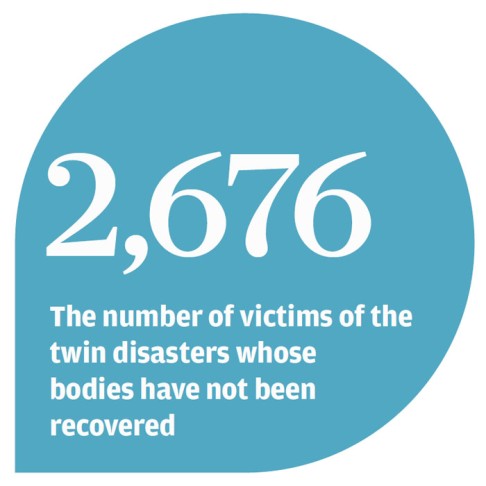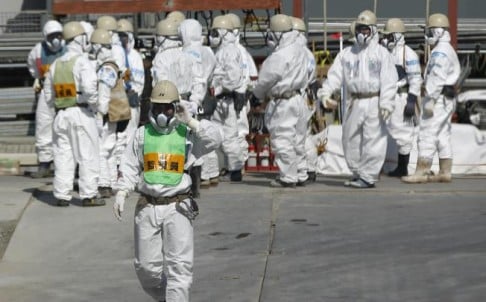
Survivors of 2011 Japanese quake and tsunami struggle to rebuild their lives
Two years after a quake and tsunami hit Japan's northeast, survivors still seek to rebuild their lives but reconstruction has been painfully slow
Along the wide beaches and in the narrow inlets that make up the spectacular coastline of northeast Japan, the search teams were out again at the weekend.

And as Japan today marks the second anniversary of the worst natural disaster to befall the nation in living memory, there is a fresh impetus to find the 2,676 people whose bodies have never been recovered.
Made up of volunteers from communities that were rattled when the magnitude-9 quake struck offshore on March 11, 2011, then laid waste when the tsunami roared in from the ocean, the search teams take short breaks for coffee and rice balls. In luminous waterproofs, they perch on rocks to catch their breath. And then they start again.
There is a sense among many people that efforts to rebuild the lives of the survivors cannot fully go ahead until the lost have been accounted for and mourned.
As the weeks turn into months and years, however, that is becoming more difficult to achieve.

According to the National Police Agency, the bodies of 15,811 victims of the disaster have been recovered to date, the vast majority from the three hardest-hit prefectures of Iwate, Miyagi and Fukushima. Of that total, the remains of 132 people have not been positively identified.
The remains of their communities are, in many cases, in little better shape.
From Kamishi in the north, down through the towns of Ofunato, Kesenuma, Onagawa, Ishinomaki and Sendai, progress over the last two years on the worst-affected stretch of coastline can be measured in what is no longer present.
The twisted steel girders, overturned fishing boats and crumpled cars that were left in the wake of the tsunami, which in some places was nearly 40 metres high, have been taken away. The debris of people's everyday lives - pots and pans, clothes, magazines, records - have been sorted into piles for recycling and taken away in heavy trucks.
Homes, mum-and-dad stores and factories are gone. Heavy tombstones are often the only clue that a temple one stood on a particular site. Undergrowth has begun to reclaim the foundations that are all that remains of the buildings that made up these communities.

While the reminders of this town from before the tsunami have gone, precious little has been put back in its place.
The reasons, and problems, are manifold. Residents do not have the money to rebuild or are being hampered by boundary disputes or local authorities' insistence on building protocols being followed. Elsewhere, communities are divided on whether they should rebuild on land that was inundated by the ocean or abandon areas that have been in their families for generations to rebuild on higher ground.
All the while, they say, the national government is not doing enough to assist them.
"We thought that, given time, the situation would get better and that in a year or two things would be more or less back to normal," said Futoshi Toba, the mayor of Rikuzentakata. "But it's the second anniversary now and, frankly speaking, the reconstruction efforts have not proceeded very well at all.
"My sense of hopelessness for the future is shared by many of the victims," said Toba, whose wife was among the 1,734 townsfolk killed in the disaster. "There are several reasons why the reconstruction work is so slow, but the biggest problem is the government's way of thinking.
"On the face of it, politicians seem to be very supportive of us and talk about this 'unprecedented disaster' and how we must all work together to help the people of Tohoku recover, how we are all working side by side," he said. "Those are beautiful phrases, but they bear very little relation to the reality."

In Fukushima prefecture, to the south, the date for a return to normality for dozens of towns and villages is in the decades.
In towns within the exclusion zone around the Fukushima Daiichi nuclear power plant, virtually everything is the same as when the people fled. The shattered glass front of a restaurant still lies on the floor, cars are parked in driveways covered by a layer of grime and smallholdings have been reclaimed by weeds.
On the journey into the plant, as part of a group of journalists given a tour of the facility by Tokyo Electric Power, there is a steady flow of vehicles on the roads to the plant - although all the occupants are covered in protective suits, gloves and breathing masks - while outside not a soul is to be seen.
A tractor sits in a field where it was abandoned two years ago. A little further on, a hawk circles in the startlingly blue sky, which also outlines the four wrecked reactors at the plant. In every direction, workers in the same white coveralls, their names on their chests and backs, are going about the tasks required to first fully stabilise the plant and later - much later - decommission it.

"Radiation levels at units one, two and three are very high and the cause of that is the fuel that has melted inside the reactors," he said. "Radiation levels within the buildings are all very high, although the level at Unit 4 is lower, even though it suffered a hydrogen explosion."
No one has been able to enter the other reactor buildings since they were crippled by the tsunami and the true scale of the problem in those units is still not clear.
Even outside the shattered shell of Unit 3, the radiation reading on the dose meter has risen to 1,710 microsieverts an hour. The level at the main gate of the plant was 8.4 microsieverts.
The average exposure from all radiation sources for a member of the public is one quarter of one millionth of a sievert.

The only success that he can report so far is with reactor No4, and that is largely because the unit was undergoing an inspection at the time of the disaster and its 1,533 fuel rods were stored in a spent fuel pool and out of immediate harm's way.
The power company has played down fears about the safety of the pool, which is on the third floor of a building that was badly damaged, although it has carried out extensive remedial and reinforcement work. Some nuclear experts have argued that another major tremor could bring down the pool and expose the rods to the air, which would be an even greater catastrophe than has already befallen northeast Japan.
To ease that danger, the company is constructing a huge tower alongside the building that will house a crane designed to lift the rods into casks and then lower them to ground level where they can be taken to a secure site, Takahashi said. The crane should be ready to go into operation in November, he said.
But that project is arguably the most straightforward task that Tokyo Electric Power faces at the site, and Takahashi agrees that it will take at least 30 years before a plant that has become synonymous with nuclear disaster can be fully decommissioned.
Jun Hirayama is the site manager for the plant's construction office and is overseeing the effort to remove the rods from the used fuel pool in Unit 4.
He had worked at the plant before the disaster and, immediately after the three hydrogen explosions tore the reactor buildings apart, volunteered to return.
"I was in charge of this section of the plant before, so I said that I wanted to come back again," he said. "The working environment is tough, particularly in the summer as the safety equipment is heavy and it gets very hot. Radiation levels are also quite high, but my aim is to get the plant back to a stable condition."
Everyone agrees it will take about 40 years to fully decommission the plant. While radiation levels in the surrounding villages and countryside are steadily falling, few want to return.
Emperor Akihito and Empress Michiko will attend a special memorial service today at the National Theatre in Tokyo. There will be speeches by politicians promising a brighter future for the people of Tohoku.
Rin Yamane will also address the event and explain how she, as a teenage girl who lost her mother in the disaster, is trying to come to terms with her new life.
Yamane survived by clinging to a length of wood amid the waves and then climbing onto the roof of a building. But the next time she saw her mother was in a makeshift morgue. Yamane says her ambition is to work for an emergency aid organisation and to help victims of other natural disasters around the world.
